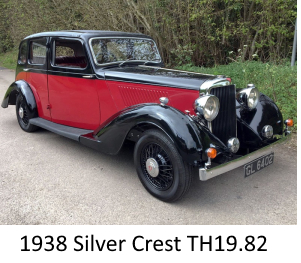Silver Crest Description
Introduced in September 1936, initially as 'The Seventeen' (type TF - 16.95 hp) this model marked a new direction for Alvis withthe intention being to provide more spacious coachwork than the other 6 cylinder cars in the current range whilst still providing the performance customers expected. George Lanchester was brought in to oversee the design following the take over of Lanchester Cars by Daimler.
Suspension was by semi elliptic springs at the rear and by two transverse quarter elliptic springs at the front, splitting the front spring allowed the engine to be moved forward in the chassis giving increased legroom in the passenger cabin.
Steering was by a Burman Douglas worm and nut steering box with the suspension controlled by Luvax automatic shock absorbers. The chassis also featured a Smith's 'Jackall' hydraulic jacking system operated by lever located under a hatch in front ofthe passenger seat. In a cost saving departure, the Alvis braking system was replaced by the Bendix Cowdrey mechanism with 3" brake drums, the hand brake operating on the rear wheels only. 16" 'bolt on wire wheels were fitted with low pressure 'balloon' tyres. A Tecalmit chassis lubrication system feeding engine oil drawn from the sump to 12 chassis points every time the clutch pedal was depressed.
The 6 cylinder engine marked a departure from previous Alvis types, being of cast iron mono block design with the timing gear located at the front. The 'Seventeen' engine had a capacity of 2362cc, with overhead valves and vandervell shell bearings.
Initially being fitted with a single Solex carburettor, however, following customer feedback, the specification was soon changed to triple SU's with fuel supplied by a single SU electric pump. The renowned all synchromesh 4 speed gearbox was specified but with a clutch bell housing connecting it to the engine.
During 1937 the 'Twenty' (type TH - 19.82 hp) model was introduced with engine capacity increased to 2762cc by enlarging the bores from 67.5mm to 73mm and larger SU carburettors. Simultaneously the cars were named the 'Silver Crest', continuing in production until 1939.
Standard saloon coachwork was by Holbrook bodies, available as four light and six light models, a DHC was offered with coachwork by Cross and Ellis with a small number of chassis fitted with DHC bodies by Maltby, one limousine was built by Crossand Ellis.
Silver Crest TF16.95

Introduced in September 1936, initially as 'The Seventeen' (type TF - 16.95 hp) this model marked a new direction for Alvis with the intention being to provide more spacious coachwork than the other 6 cylinder cars in the current range whilst still providing the performance customers expected. George Lanchester was brought in to oversee the design following the takeover of Lanchester Cars by Daimler.
Standard saloon coachwork was by Holbrook bodies, available as four light and six light models, a DHC was offered with coachwork by Cross and Ellis with a small number of chassis fitted with DHC bodies by Maltby, one limousine was built by Cross and Ellis.
Silver Crest TH19.82

During 1937 the 'Twenty' (type TH - 19.82 hp) model was introduced with engine capacity increased to 2762cc by enlarging the bores from 67.5mm to 73mm and larger SU carburettors. Simultaneously the cars were named the 'Silver Crest', continuing in production until 1939.
Standard saloon coachwork was by Holbrook bodies, available as four light and six light models, a DHC was offered with coachwork by Cross and Ellis with a small number of chassis fitted with DHC bodies by Maltby, one limousine was built by Cross and Ellis.